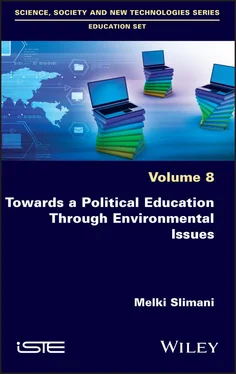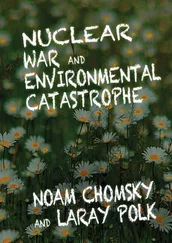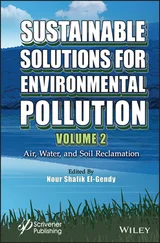– information about the food system based on a democratic theory that recognizes the importance of individuals with the knowledge to participate effectively;
– sharing ideas about the food system with others through ongoing discussion and deliberation that allows citizens to clarify food issues and discuss related values;
– developing the effectiveness of food systems in a political system which builds skills among citizens to determine a proper relationship with their food and resolve community food problems;
– orientation towards “community goods” by involving citizens who care about the public good and who are willing to look beyond their own interests and recognize the value of mutual support and interdependence.
1.3.5. Issues concerning environmental technology and environmental management
Environmental technologies are socio-technical systems. They correspond to the expansion of environmental concerns in technology products to socio-technical systems (Kanda et al . 2016).
Environmental technologies include:
– clean technologies such as renewable power generation and energy consumption technologies;
– recycling technologies;
– water, air or soil pollution control technologies;
– technologies developed with the specific objective of repairing damage caused by human activities through the application of biotechnology for the remediation of contaminated sites or through the application of innovative agricultural techniques to restore biodiversity (Smith and Stirling 2008, 2010).
There is a classification that proposes three categories of environmental technologies (Vachon 2007), where the term “technology” is broadly defined to include the design, equipment and operating procedures that limit or reduce the negative impacts of products and processes on the natural environment. In this classification, environmental technologies include:
– pollution prevention technologies, which are defined as structural investments that reduce or eliminate pollution at the source;
– pollution control technologies, which are structural investments that ensure proper waste disposal, reduce the release of pollutants or correct environmental damage;
– management systems, which are infrastructure investments that propose improvements to environmental performance through environmental impact assessment procedures when making investment decisions.
Additionally, environmental technologies have the characteristic of integrating a broad socio-political agenda of sustainability. This allows them to internalize, along with medical technologies and information communication technologies, the issue of desirable societal transformation. In fact, thanks to the idea of technological efficiency, environmental technologies that develop in the context of a sustainable development project make political content visible in the technological design (Valkenburg 2012).
Environmental management is a range of tools and procedures aimed at evaluating and subsequently reducing the impact of the activities of one or several businesses through environmental analyses or management control systems. Dohou-Renaud (2009) proposes a classification of environmental management approaches.
According to the same author (Dohou-Renaud 2009), environmental analyses and environmental management systems are based on two approaches: an environmental management approach called the “product approach” and another called the “organizational approach”:
– the product approach includes life cycle analyses, which constitute a true environmental cost accounting system that enables an energy balance to be made by evaluating the impact of the production of goods or services on the environment;
– the organizational approach consists of designing or improving the design of products in order to minimize their impact on the environment by using life cycle analysis, resulting in the communication of environmental labels such as eco-labels.
Moreover, according to Dohou-Renaud, behind the adoption of these environmental management technologies, there are always institutional pressures from stakeholders such as environmental advocates, market players and organizational players (managers, shareholders, employees, etc.).
Reed (1996) discussed the issues and contexts that have historically guided theories in organizational science. According to this author, justice appears as a metanarrative framework for organizational analyses in the transitional context towards participatory democracy. In fact, this framework raises fundamental questions in organizational studies about the types of governance and control in contemporary organizations and their moral and political foundations regarding justice. It affirms the centrality of questions relating to the distribution of political, economic and cultural power. The emphasis on practices that cut across organizational structures and processes, such as the state, social class and professions, reveals the strategic role played by power struggles between institutional actors in shaping and reforming systems of rules that guide the political and economic actions of corporations and organizations in general (Reed 1996).
1.3.6. Issues of transitioning to sustainability
Transitions are processes of change from systems associated with social services such as housing, transportation, energy, food and water supply to more sustainable systems. They are
processes of fundamental social change in response to societal challenges. They reflect a particular diagnosis of persistent social problems, in which persistence is attributed to the path dependency of dominant practices and structures (i.e. “regimes”), whose resolution requires long-term and structural change. By their very nature, transitions involve politics in the broadest sense of the word. (Avelino et al . 2016, p. 557)
According to Loorbach et al . (2017), the concept of regime, defined as a dominant and stable configuration in a societal system, is the most central notion in transition studies. This idea is at the heart of an original perspective in transition analyses: the multi-level perspective (MLP). The latter draws its origins from historical studies of system change on the one hand, and from the evolutionary economy on the other. It recognizes the co-evolutionary development of technologies, institutions and economic subsystems by putting forward the presence of three levels whose dynamics and interactions make it possible to understand transitions: the landscape or macro-level, the regimes or meso-level and the niches or micro-level.
The landscape (macro) level is composed of the overall socio-technical framework and macro-political developments that form the context of the transition. It is a kind of backdrop for the other two levels by stimulating and exerting pressure on the socio-technical regime.
The regime (meso) level comprises the structures that represent the practices and routines at stake, such as the rules and dominant technologies that ensure the stability and strengthening of the prevailing socio-technical systems. It can also be a barrier to change technological and social innovations.
The niche (micro) level is a designated space for experimentation and radical innovation. This level is loosely structured compared to the regime level. It is less influenced by the market and regulation. Coordination between niche actors is weaker than between regime actors. This allows the emergence of new interactions between actors that can support innovation (Loorbach et al . 2017).
Twomey and Gaziulusoy (2014), in a literature review on innovations and transition theories, note that “socio-technical transitions” is an umbrella term that includes two other perspectives in addition to the multi-level perspective (MLP): the transition management (TM) perspective and the strategic niche management (SNM) perspective. In fact, according to these authors, the latter two perspectives are derived from the former.
Читать дальше












